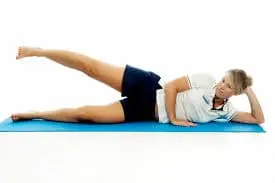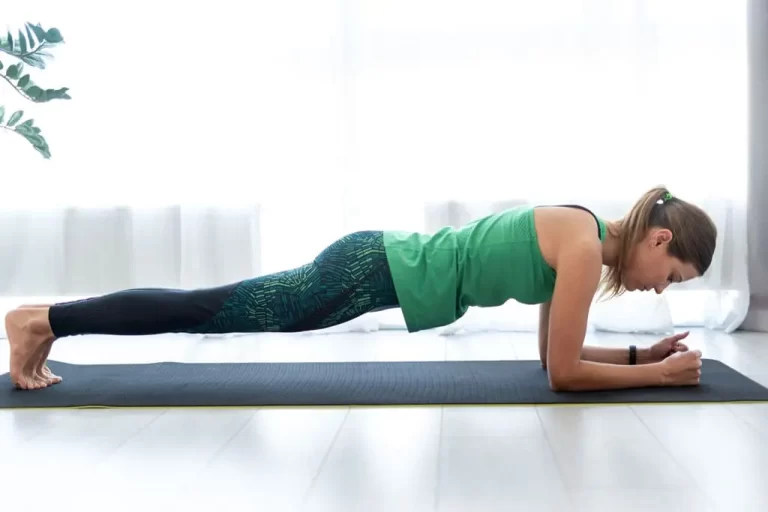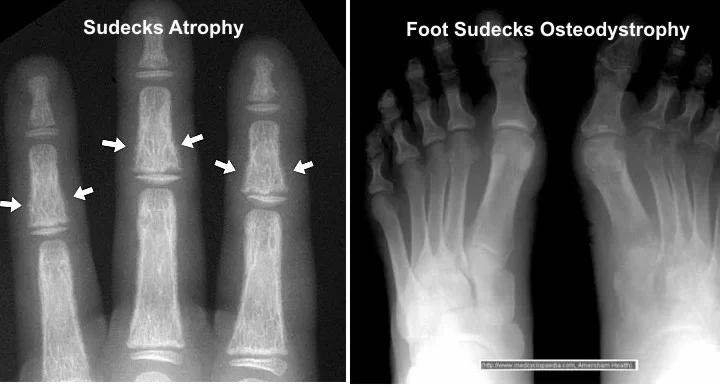51 Best Exercises of Latissimus Dorsi Muscle
The latissimus dorsi, commonly referred to as the “lats,” are among the largest muscles in the back, playing a crucial role in various upper body movements and providing a strong, V-shaped appearance.
Understanding the best exercises for the latissimus dorsi is essential for anyone looking to build a well-rounded, strong, and aesthetically pleasing upper body. This introduction delves into the significance of these exercises and sets the stage for exploring the most effective ways to target and strengthen the lats.
What is the Latissimus Dorsi Muscle?
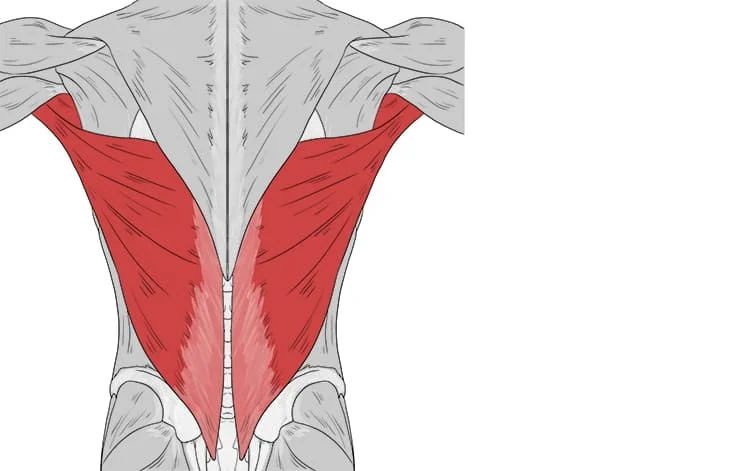
- The largest muscle in the human body is the latissimus dorsi, also known as “the lats” or “the lats muscle.” Almost all of the back muscles at the posterior trunk are covered by this rather thin structure, as opposed to the trapezius muscle.
- The latissimus dorsi is a component of the superficial layer of the extrinsic back muscles, together with the rhomboid, levator scapulae, and trapezius muscles.
- The latissimus dorsi muscle is a member of the scapular movement’s functional muscle group. This muscle has the ability to pull the scapula’s inferior angle in various directions, which can cause motions in the shoulder joint, including internal rotation, adduction, and arm extension. In addition, it is a major stabilizing muscle for the spine during its various movements and helps in respiration.
Relations of the Latissimus Dorsi Muscle
- The serratus posterior muscles are covered by the superficial latissimus dorsi muscle, which is located in the lower two thirds of the trunk. The superficial, or latissimus dorsi, is where the teres major muscle is located. A bursa separates but unites the adjacent fibres of these two muscles in the direction of their humeral attachments. The posterior axillary fold is formed by the latissimus dorsi and teres major, which extend between the scapula and proximal humerus. When the arm is adducted against resistance, the fold is more noticeable. The entire inferolateral border of the latissimus dorsi, up to where it attaches to the iliac crest, can be felt during this movement.
- The lumbar triangle’s medial margin (of Petit) makes up the lowest portion of the latissimus dorsi’s lateral margin. The iliac crest and the external abdominal oblique muscle complete the triangle inferiorly and laterally, respectively. The floor of this area was the internal abdominal oblique muscle.
- The auscultation triangle, another significant anatomical feature, is part of the latissimus dorsi muscle. The latissimus dorsi (inferiorly), medial edge of the scapula (medially), and trapezius (superiorly) define the boundaries of this area. The lower pulmonary lobes become subcutaneous inside the auscultation triangle when a person bends their arms over their chest and bends their trunk forward, making them ready for the stethoscope to be used to auscultate respiratory sounds.
The latissimus dorsi muscle’s functions include:
- The glenohumeral is the articulation that extends the shoulder joint.
- The latissimus dorsi muscle acts on the shoulder joint in three different ways because of the multidirectional attachment of its fibres:
- It extends the flexed arm in an efficient manner.
- The arm is internally rotated and adducted.
- When the humerus is stabilised in opposition to the scapula, the entire pectoral girdle is pulled back.
- These movements establish the latissimus dorsi muscle’s complicated functional activity; it is a muscle used for swimming, rowing, and climbing.
- Climbing muscles include the latissmus dorsi. With the aid of a pectoralis major muscle, it is able to raise the trunk upward while the arms are fastened above the head.
- It is a key muscle for swimming, rowing, and chopping, particularly on the downstroke. As the muscle attaches to the ribs, it also takes part in forceful expiration. The muscle can be felt pushing firmly inside during coughing or sneezing because it compresses the abdomen and thorax.
- The muscle facilitates the scapula’s retention against the thorax during movements of the upper extremities. This movement was made possible by the muscle’s alignment with the scapula’s inferior angle.
- Latissimus dorsi may pull the trunk forward in relation to the arms during activities such as crutch walking, when the humerus is the fixed point when standing. The pelvis is also raised during this move. The ability to move the pelvis and trunk is provided by the latissimus dorsi’s attachment to the pelvis and its continued innervation in individuals with lower limb paralysis. This means that those who use crutches and callipers can produce a modified gait by hitting the hips and fixing the arms with sequential contractions of the latissimus dorsi muscle on each side.
The latissimus dorsi serves a number of important supporting roles. These include:
- The pectoralis major muscle and the arms fastened above the head will cooperate to elevate the trunk upward.
- When performing humeral motions at the shoulder joint, it secures the scapula against the thoracic cage.
- With the humerus stabilised as the standing point for those who use crutches, the latissimus dorsi helps pull the trunk forward by fixing the humeral alignment.
- The pelvis is raised as a result of this motion. This action makes it possible for those who are paraplegic to move their trunk and pelvis.
- By applying pressure to the rib cage, it facilitates forced expiration (accessory muscle of expiration). Because of this, the muscle that causes coughing fits occasionally gets stretched (referred to as “coughing muscle”).
- Through training in a range of diverse exercises, one can increase the power, size, and strength of this muscle.
Among these are a few:
- Vertical pull-down and pull-up exercises (including chin-ups)
- pulling workouts that are horizontal in nature, like the T-bar row, bent-over row, and other rowing exercises
- Exercises that involve straight arms and shoulder extension, including pull-overs and lat pulldowns
- Deadlift
Exercises for the latissimus dorsi muscle:
The big V-shaped muscles that attach your arms to your vertebral column are called the lats, or latissimus dorsi. They give your shoulders and back strength while stabilizing and protecting your spine.
Additionally, your lats support proper posture and aid in shoulder and arm mobility. For the purpose of increasing upper-body strength, enhancing range of motion, and avoiding injuries, latissimus strengthening and stretching are crucial.
Stretching exercise for the latissimus dorsi muscle
You can improve your range of motion, enhance flexibility, lessen pain, and avoid injuries by stretching your lats a few times a week.
Why Does the Latissimus Dorsi Muscle Get Tight?
- It’s highly likely that you spend much of the day with your arms resting at your sides.
- (Consider while you’re walking, running, using a computer, etc.)
- This shortens the Latissimus Dorsi muscles (and does so for extended periods of time!).
- As a result, many people may have common tightness in this muscle!
Quick advice:
- Never push yourself past pain.
- Maintain the most relaxed posture you can. “Sink” into the length of it.
- By inhaling deeply, you can extend the stretch once you’ve reached a respectable one.
- To precisely target certain muscle parts, learn to bend your spine.
- The portions that follow are arranged in order from least to most intense.
When should I stretch?
- Make sure you perform these exercises with appropriate form and technique for the greatest possible benefit. Only extend as far as feels comfortable. You should never push yourself into a posture that hurts or is uncomfortable.
- Stretch your muscles while they are warmed up, ideally after a brief warm-up or at the conclusion of a workout. You can perform each exercise multiple times or all at once during the day.
- Perform these exercises three times a week or more for optimal benefits.
The best exercise to stretch the latissimus dorsi:
Stretching exercise for the latissimus dorsi muscle
Wall Lat Pulls
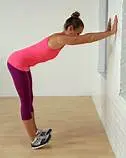
Place your hands on the wall at the waist and shoulder-width while standing with your back on the wall.
Take a step backward and fold your hips until your arms and torso are in a straight line. The rear ought to stay flat.
Utilize your abdominal muscles to stabilize your lower back’s arching. As an alternative, place your forearms upright against the wall and extend your elbows downward. The table can be used in place of the wall when performing the stretch.
Additionally, at the lowered position, the body is inclined towards the bar. Bar stretches should be performed with both arms, and they should be held for 30 seconds.
Utilize a foam roller to stretch
For this exercise, a foam roller is required. Foam rolling is an effective way to reduce discomfort, improve range of motion, and realign muscles that are knotted or stiff.
Pay close attention to any regions that feel tight, sore, or sensitive when you roll. To make sure your lat isn’t being overworked, engage your opposing arm and lower leg.
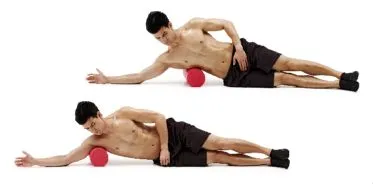
Lay a foam roller beneath the lat, as the illustration below illustrates.
Using the legs, move the entire body forward and backward so that the roller massages the upper back. Maintain a relaxed upper body and regular breathing patterns.
If the exercise is comfortable and you don’t experience any pain, you can perform it for 15 to 90 seconds. You can perform this exercise with your arms across your chest and your hands behind your head.
Dynamic floor stretching
Sink your hips back and rest your right forearm on the ground while kneeling.
With your left arm extended and your fingertips pointing outward, shift your weight onto your right arm. There will be a stretch along your side.
For a few moments, maintain this pose.
Go back to where you were before.
Ten times over, repeat. On the other side, repeat.
To get the most out of the stretch, circle your lower back. As you extend, turn your ribs and chest towards the ceiling to deepen the pose.
Pose of an Extended Child on Fingertips:

The sufferer is on their knees on the ground.
When the patient is sitting on their heels, try to touch their big toes together.
Next, divide the knee joint by a width equal to that of the hip joint.
Next, extend the hands as far in front of them as you can while bending forward from the hip joint.
With your arms outstretched and your palms facing downward, raise yourself onto your fingertips as though a ball is beneath your hands and is melting your chest down towards the ground.
Stretch Your Sides, Lying Parallel Arms, Chest:
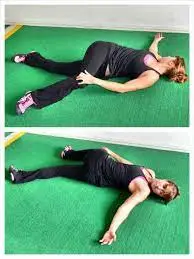
The patient is on their stomach, lying prone. They extend both arms to the sides, forming the letter T with their palms facing downward.
Then, using your left hand to push, begin rolling to the right.
Raise your left leg, flex your knee, and plant your left foot firmly on the ground for balance.
Next, place the right temple back on the ground.
Has to be For balance, keep your left hand on the ground.
Raise the left hand towards the ceiling to experience the added stretch.
Next, extend the opposite side in the same manner.
Throughout the stretching routine, you may repeat this posture multiple times.
Stretching with an exercise ball
For this stretch, you will need a chair or an exercise ball. This stretch enhances overhead mobility and lat lengthening. Stretch in a slightly different way by placing your palm—either up or down—on the ball.
Start with your feet up on a tabletop, facing an exercise ball.
With your thumb pointing towards the ceiling, place your right hand on the ball.
Strike your grounded arm to provide support and stability.
Roll the ball forward by extending your arm straight out and contracting your core muscles.
Take a few deep breaths and hold this pose for twenty to thirty seconds.
On the other side, repeat. Repeat each side three times.
You can perform this stretch while standing with the ball or chair in front of you for a little different variation. As you roll the ball forward, align your arm in the same manner and pivot at the hip.
Stretches with yoga
You can practice a basic yoga exercise that strengthens and stretches your lats. As you perform the poses, pay attention to how your muscles are feeling.
Try this exercise on its own or as a component of a longer training programme. These positions can aid in the release of tension, pain, and stress.
Salute Upward
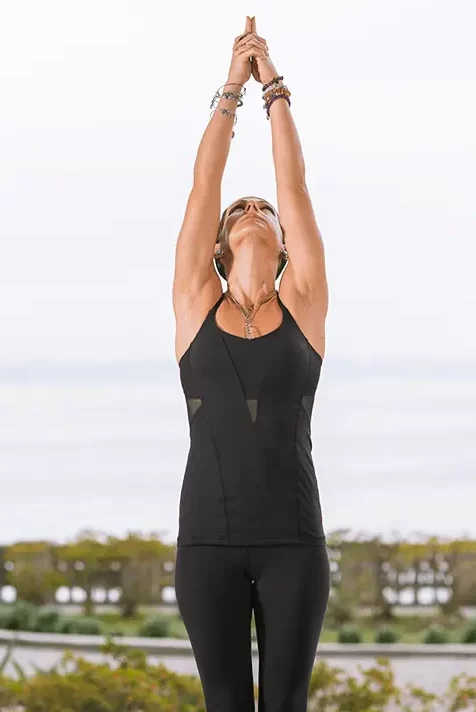
Another name for the Upward Salute (Urdhva Hastasana) is Palm Tree Pose or Raised Hands Pose. This position extends your lats as well as your shoulders, armpits, spine, and sides of your body.
Start out in Tadasana, or mountain pose, with your heels slightly apart and your weight equally distributed over both feet.
Raise both arms towards the sky.
To maintain your spine’s alignment, contract your core and tuck in your tailbone just a little.
Lean back a little if it makes you comfortable.
The Eagle Pose
You can perform Eagle Pose (Garudasana) either sitting or standing. Your shoulders and upper back’s range of motion can be improved with this pose.
Both arms should be extended straight ahead while remaining parallel to the ground.
To place your right arm above your left, cross your arms in front of your upper torso. Extend your elbows.
Raise both forearms so they are perpendicular to the floor, and tuck your right elbow into the crook of your left elbow.
Breathe deeply while pressing your palms together and concentrating on releasing tension in your shoulders and back.
Turn your arms over and do it again.
Child’s Position
Balasana, also known as Child’s Pose, is a healing pose that stretches your lats and helps you relax your neck, shoulders, and spine.
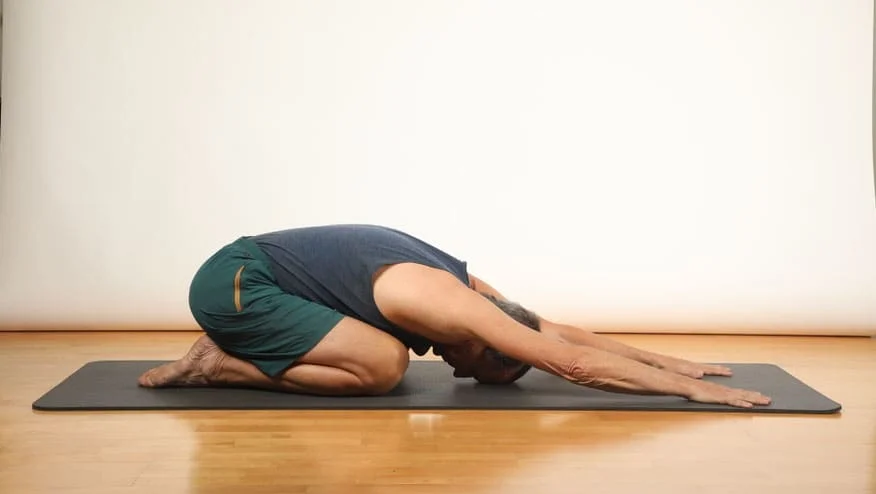
Exhale after taking a deep breath while in Downward Dog. Pull your hips back to your heels and release your knees to the floor. Press your forehead to touch the ground.
With your knees a little wider than your hips, you can also unwind in this pose.
Stretch your fingers as far forward as you can to make the stretch deeper. After moving your fingers to each side, return them to the center and lie down in this posture.
Lat Dorsi Stretch:
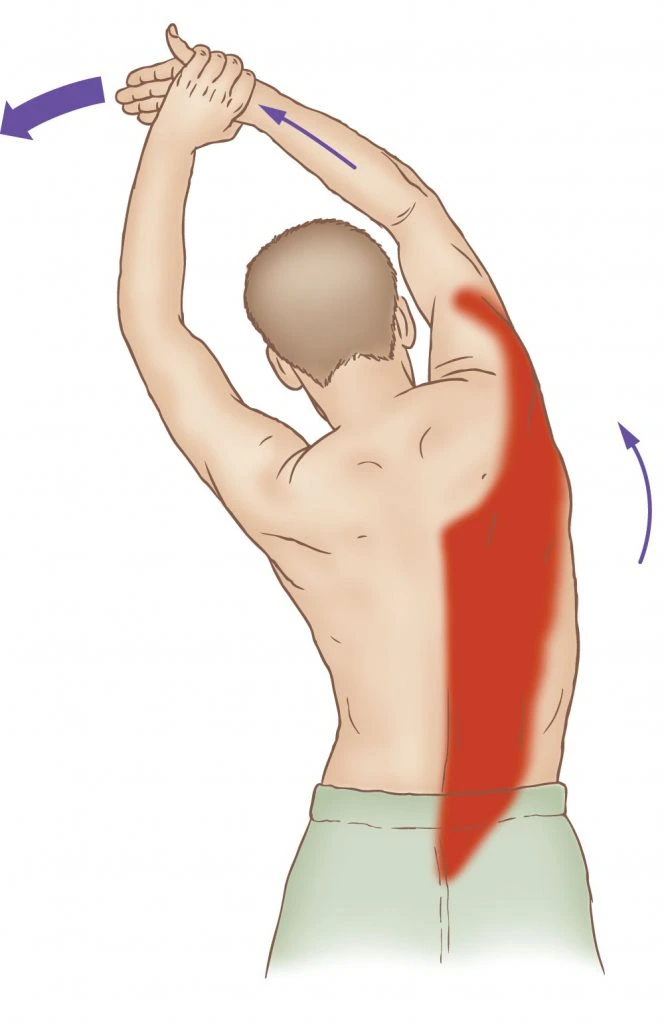
Place yourself upright near a high table or shelf. Put your elbows down on the table or shelf. Stretch the area around the hollows of both shoulders by bringing your knees down slightly and repositioning your hips without extending your arms. The latissimus dorsi muscle will stretch as a result; you will feel the stretch under your armpit and in the direction of your shoulder blade. Repeat three times, holding the stretch for 30 to 45 seconds each time.
Dowel Abduction from Above:
With your good arm, help your sore arm move away from your body by holding a dowel rod above your head. Until your therapist tells you otherwise, only go as far as you feel comfortable. In the latter phases of shoulder rehabilitation, this exercise aids in increasing shoulder mobility. You can use a golf club or broom stick in its place if you don’t have a dowel rod. Pushing the stretch at the peak of the action, repeat ten times on each side. Do this three times.
Pulling elbows

Guidelines:
Put your hand down in the middle of your back.
Hold the elbow of the hand that is reaching down your back with your other hand.
Assist the midline with the elbow pull.
Lean your body to one side.
For 30 seconds, hold.
Laying On Your Side on an Exercise Ball
Guidelines:
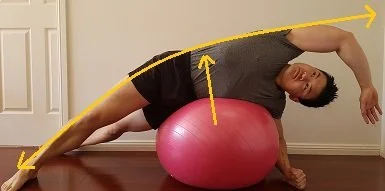
Using an exercise ball, lie on your side.
To keep your balance, place your feet close to a wall.
Reach over with the arm out to the upper side.
For 30 seconds, hold.
Stretch Your Lats While Sitting on chair
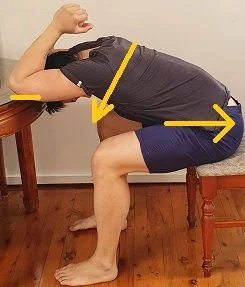
Guidelines:
With a table in front of you, take a seat in a chair.
Put both of your elbows on the table’s edge, pointing forward.
Shift your hips out of line with the table.
Permit your chest to droop.
For 30 seconds, hold.
Door Frame Slanted
Guidelines:
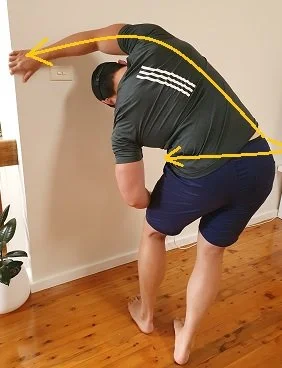
Take up the above position.
With your hand, grasp a door frame.
As you anchor your legs as demonstrated, try to flex your midsection as much as you can.
Apply your body weight as you relax into the stretch.
Put your pelvis in a twist.
Try to feel your side body getting stretched.
Hold for thirty seconds.
Spinal twist while seated:
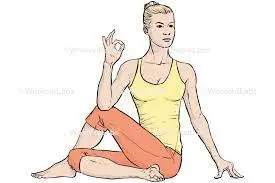
seated with both legs out in front of oneself on the ground.
Place the foot outside of the right thigh and bend the left knee.
Position the right arm outside the left leg.
With your left hand from behind you, provide support.
Twist to the left, beginning at the base of the spine.
Take a minute or so to maintain this stance.
Continue on the opposite side.
Bending Sideways Using a Resistance Band
Guidelines:
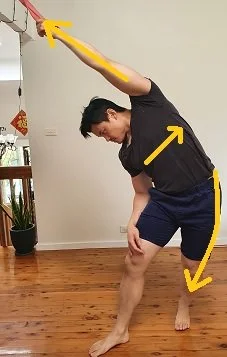
Take hold of a thick resistance band that is placed over your head.
Take a step back and extend your arm in front of you.
Keep the band well-tensioned by staying away from the anchor point.
Allow your arm to relax as you commit your whole weight to the resistance band.
By far the leg that is furthest from the resistance band should bear the most of your body weight. Put your pelvis in a twist.
For 30 seconds, hold.
Stretching in a Side Lay
Guidelines:
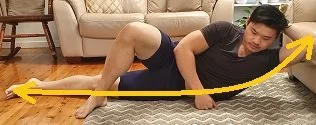
Put yourself on your side.
Put your elbow up against the plush couch’s side.
Permit your body to droop towards the ground.
Stretch your lower leg apart from your torso.
For 30 seconds, hold.
Bending Lats While Hanging
Guidelines:
Hang from a bar higher than your head
Give your body permission to unwind fully.
You can maintain a slight elevation of your feet on the ground.
For 30 seconds, hold.
You can extend it further by placing weights on your ankles.
Note: If you have problems with your neck, shoulder, or upper limb, avoid trying this exercise.
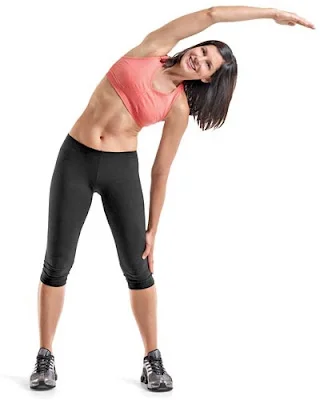
One-Arm Leaning
Guidelines:
With one hand, grasp a bar above your head.
Put your weight down on this hand.
Just place your feet lightly on the ground.
Lean in the direction of the side.
For 30 seconds, hold.
The eccentric loading of the latissimus dorsi
In order to do this, a muscle contraction must be produced when the muscle extends. This will facilitate the Latissimus Dorsi’s elongation.
Guidelines:
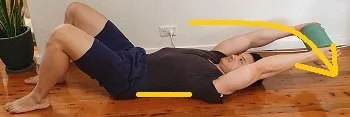
Once you are on your back, bend the knees.
Throughout the exercise, maintain a perfectly flat lower back on the floor.
Using both hands, grasp a weight that is difficult.
Avoid allowing your lower back to arch as you gradually reduce the weight above your head.
When you reach the bottom of the exercise, try to feel a stretch in your lats.
Ten times over, repeat.
Strengthening exercises for latissimus dorsi
Exercises that emphasise pulling and lifting actions are key to strengthening the latissimus dorsi:
One Leg, One Arm Row
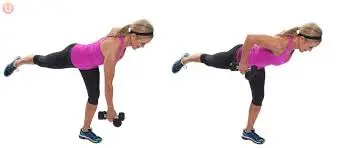
Because doing a row on one leg presents a balancing problem, you will typically use a smaller weight.
First, shift your weight to your left leg and tip your hips, bringing your trunk line to the floor as you raise and elevate your right leg. maintain correct alignment of the body from head to heel.
If necessary, you can control onto a wall for balance.
Pull your elbow upwards into a row and then slowly lower yourself from this posture.
Keep the majority of the dumbbell in front of your leg, take a moment to relax, and rest lightly on your toes if you’re feeling tired.
Do this ten to fifteen times.
Lat Pulls While Using Bands
The lat pull machine at the gym was fascinated by this activity.
To increase the difficulty of this workout, you can either hold the band above your head and use your back muscles to bring your elbows down towards your rib cage, or you can use a door holder for the band and place it in a doorway above you.
Hold the band with your hands closer together to increase the difficulty of this exercise.
You may also try doing this one arm at a time for a more targeted exercise.
Do this for 12–16 repetitions.
Barbell Rowing
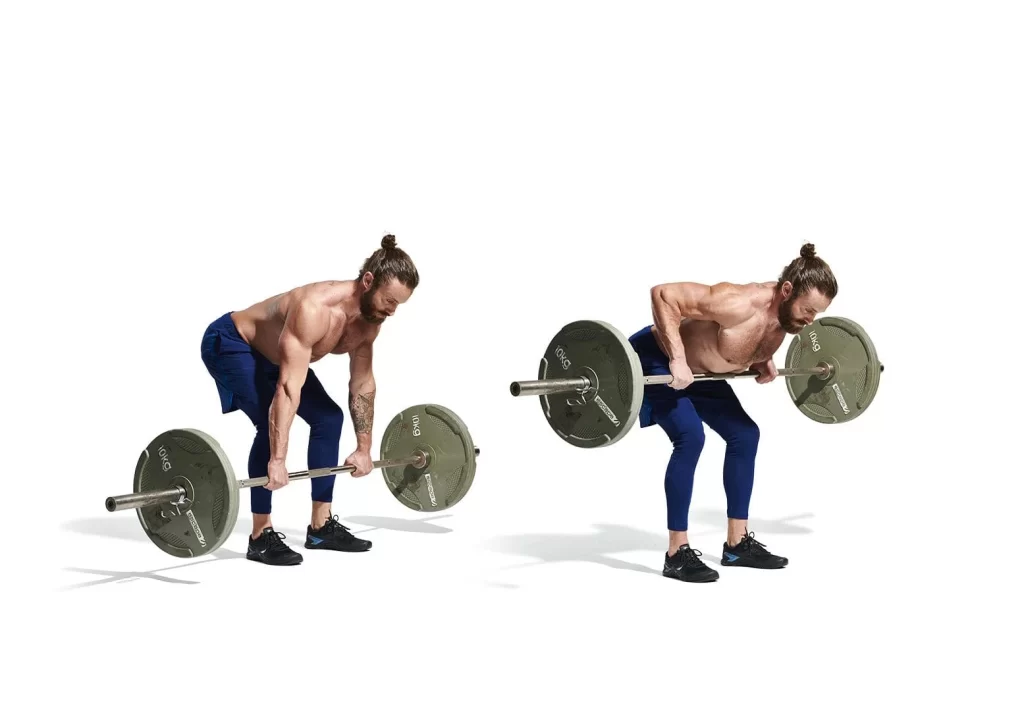
You can work each side independently with dumbbells, but you can lift a healthier weight with a barbell than you could with individual weights.
You must hold the barbell for this exercise with your palms facing your body and tip it from your hips until your trunk is almost at a 45-degree angle.
Avoid lowering your trunk too much, as this might put strain on your back, particularly if you are carrying a lot of weight.
Flex your knees to cushion your back, then lift the barbell straight out and squeeze your back to bring it in towards your umbilicus.
Repeat ten to twenty times. This exercise can also be done with the palms facing out, like a biceps curl.
Pullovers with dumbbells
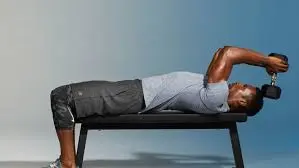
Due to their ability to simultaneously target the latissimus, chest, and triceps, pullovers are the ideal workout. You also engage the lower leg and core when performing these exercises on the physioball. You must begin this exercise by assuming the bridge position and lifting a weight straight up overhead.
Start with a lightweight if you are unfamiliar with this motion.
Lower the dumbbells beside you to roughly head level or as far as feels comfortable while maintaining your arms extended and your elbows slightly bent.
Repeat for 12 to 14 repetitions, squeezing your back and bringing the weight back to the starting position gradually.
Row of Renegades
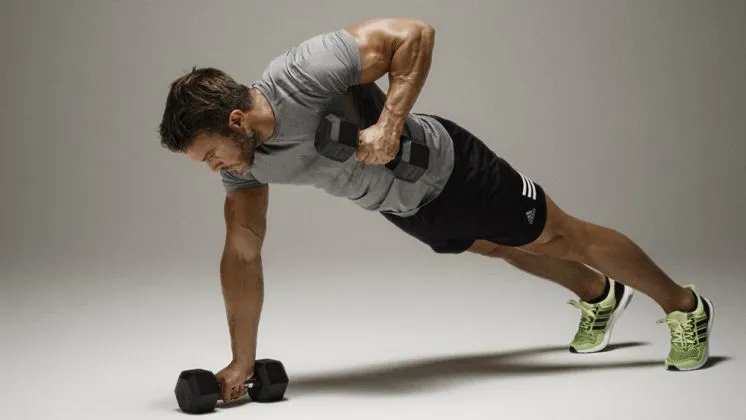
You must start this workout by forming a plank position on your hands and toes or on your knees. Hold onto two dumbbells so that your palms face each other.
Try this one hand at a time if it irritates the hands.
alternating between rowing each weight up and down for 10 to 16 repetitions while maintaining the plank posture.
Should you find this exercise too difficult, try doing it on your knees, placing your hands beneath your shoulders and your knees squarely beneath your hips.
Pull-Ups
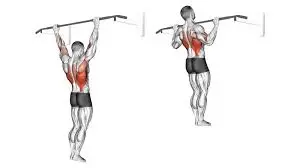
If you are new to pull-up exercises, you can learn how to adapt the technique and gradually increase your strength until you can lift your entire body.
Place a chair or step stool underneath the pull-up bar to begin. Spread your hands wider than your shoulders, place one or both feet on the chair, and utilise the leverage to raise your body.
Lower and repeat ten times or more.
You can experiment with using more from your upper limb and less from your lower limb over time.
Try implementing this change. Pull yourself up into position using a table or chair, and then carefully lower yourself down without using the chair.
They are referred to as negatives, and they are a good method for strengthening the upper limbs.
Rows with dumbbells
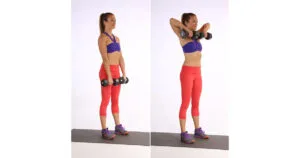
For this exercise, keep your back flat, your abs tight, and hinge from your hips.
With the weights hanging downward (they should be heavy), you bring the elbows up to the level of your trunk by squeezing your back.
Instead of yanking the dumbbells up, you want to control the movement by using your back muscles. Elbows should stop slightly above the level of the trunk.
The lower back has had to exert too much effort to maintain the body’s neutral position since you are bending over and hanging dumbbells.
If you feel tightness in your lower back, flex your knees and keep your abdominals braced.
One Arms Row
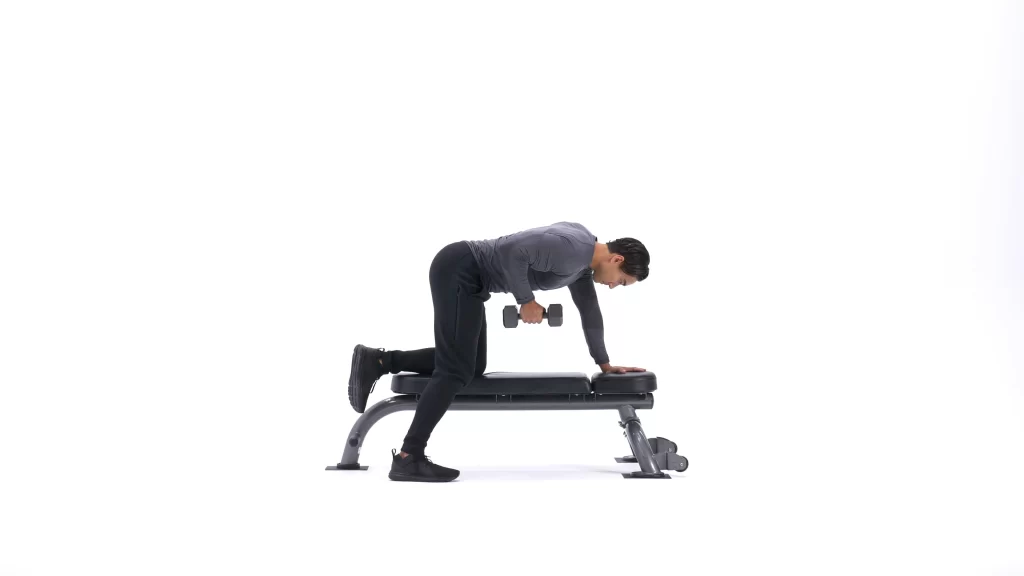
Unlike double-arm rows, when you support your lower back with one hand on the opposite leg, single-arm rows allow you to often go heavier.
For this exercise, as you engage the elbow to the level of the trunk, grip the latissimus. To engage additional muscles at the top, flex your shoulder blades together. Dumbbells down, and repeat 12–16 times on each side.
Resistance-Banded Seating Rows
Resistance bands can change the overall rowing exercise. The muscle fibres will fire somewhat differently during the activity because the resistance band provides resistance.
This is a workout that you can do while sitting or standing. Grab the handles with both hands and encircle a stable item in front of you with a resistance band. Proceed rearward until the band experiences an opposing stress.
Shoulder down, pull in your back to bring your elbows in till your trunk is in line. Repeat for 12 to 16 reps after releasing.
Row With Bent-Over Bands
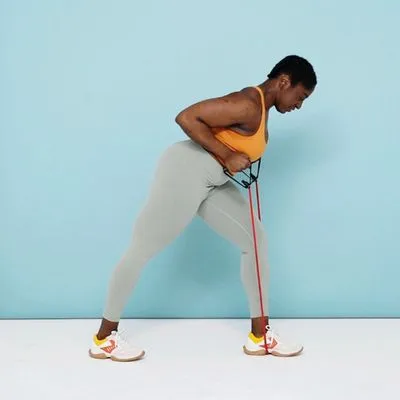
Loop the band under both ankles and grip onto it closer to the feet for this exercise.
As opposed to gripping the handles, this will allow you to increase the tension in the band.
Raise the elbow and stop at the level of the trunk while maintaining a flat and parallel back.
Do ten to twelve repetitions of this. Tempo adjustments work well with this workout as well.
Power Plank with Rows
This advanced exercise simultaneously targets two muscles. The plank exercises the lower back, lower limbs, and abdominals.
By adding a row, you strengthen your lattisimus dorsi and your core even more because you are balancing your body on one hand.
Start this exercise by putting your feet wide apart and forming a plank stance on your hands and toes. You can make this workout more difficult by doing it on your knees.
Hold a kettlebell or dumbbell and bring your elbows up into a row.
Holding the plank the entire time, lower and repeat 14 to 18 times. After relaxing, swap sides.
Dumbbell Rows with variation
A variation on the standard dumbbell row is to switch between left and right repetitions.
This exercise helps you focus on one arm at a time and engages more of your core.
To start, tip from the hips while keeping your back flat.
Raise the right elbow to the level of the trunk by slowly flexing it.
Raise and then descend your right elbow into a row.
Switch it up and take your time through ten to fifteen repetitions every set.
Pulls with a Straight Arm
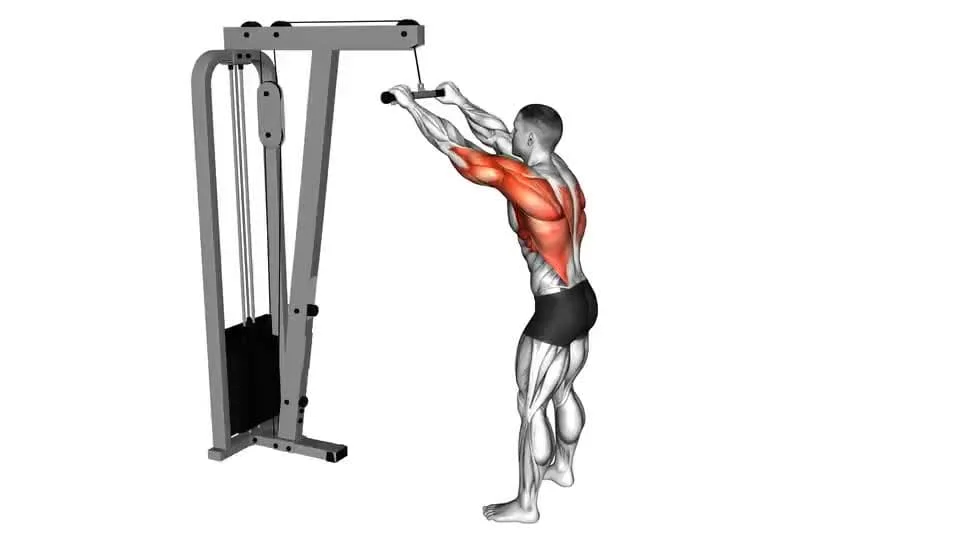
It works the triceps in addition to the back muscles.
To balance oneself on a ball, one must use their legs and lower back to stabilize their body.
In order to complete this workout, place the ball beneath your trunk and secure a band around a stable item in front of you. You are now much too far away from the band’s anchor point to experience stress.
Starting with your arms straight out in front of you, lower and bring them back behind you while contracting your back.
Repeat ten to twenty times.
Pullovers with Barbells
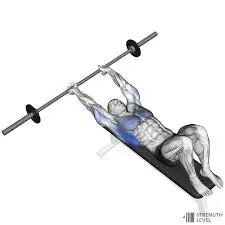
This exercise becomes much more intense when performed using a barbell.
In contrast to dumbbell pullovers, you want to maintain your elbow flexion the entire time to avoid going too far and dropping the barbell.
Start this exercise on a bench and place your hands close together, just over your ribcage, while holding the barbell.
Raise the barbell and place your arms back behind your head while maintaining your contracted elbows.
For ten to twelve repetitions, contract your back to bring the barbell back to the starting position.
Compound Row
This exercise targets the lats as well as the hamstrings, glutes, and lower back. To maximize the advantages of this workout, you can use a weighted full band.
To begin with, step next to a stable item in front of you and wrap a band around it until the band starts to feel tight.
With your arms outstretched, tip from the hips, bend your knees slightly, and tuck in your abdominals.
As you stand up, lift your elbows to your trunk level in a rowing motion.
Let go and repeat ten to twenty times.
Lateral raises:
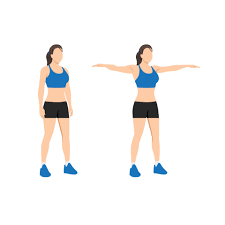
To begin, grasp a pair of light dumbbells.
Your feet are spaced somewhat further apart than the breadth of your hip joints as you stand.
Make an effort to lift the weights to shoulder level by moving them to the sides.
It’s important to keep in mind to use your core muscles and gradually reduce the weights to the sides.
Perform this exercise twice a week for three to four sets of twelve to fifteen reps each.
Exercise with a wand:
You will be able to extend your range of motion with this workout.
With the assistance of both hands, the patient is holding the wand.
Next, move your elbow and shoulder joints.
Using the wand, do the following movements: elbow flexion, extension, external and internal rotation, abduction, adduction, and shoulder flexion.
Everybody works out two or three times a day.
Exercise for isometric shoulder flexion:

You are facing a wall when you do the isometric shoulder flexion exercise.
Make a fist after attempting to flex your elbow joint on the side of your shoulder.
You steadily press your palm into the wall while holding the folded serviette between your fist and the wall.
After holding the pressure for seven to ten seconds, release it gradually.
There’s no reason to try to topple the wall.
Simply apply light pressure to the wall to engage your shoulder flexor muscles.
Perform the 12 to 15 reps.
Exercise for isometric shoulder abduction:

Your rotator cuff muscles are the main focus of this exercise.
You should stand six inches away from the wall in order to perform shoulder abduction.
Next, align your body perpendicular to the wall and in close proximity to the wall on the side where your shoulder joint is afflicted.
Press the towel into the fist you just made on that side.
For additional support, you are also using a folded towel.
You are trying to raise your arm outside while being very gently pressed against the wall.
After ten seconds, hold this pressure and gradually release the wall’s pressure.
Perform the ten to fifteen reps.
Isometric exercise for external rotation of the shoulder joint:

The latissimus dorsi and rotator cuff muscles—primarily the teres minor and infraspinatus—are strengthened by this exercise.
You must position yourself such that you are 6 inches or less from a wall in order to conduct shoulder external rotation.
The shoulder joint that is damaged is near the wall.
Make a fist after flexing your elbow joint to a 90-degree angle.
As you rotate your arm outward, try pressing the towel from the back of your hand on the wall.
Press the cloth gently on the wall after that.
Hold this pressure for five to ten seconds, then gradually release the wall’s pressure.
Perform ten to fifteen reps.
Isometric shoulder joint internal rotation exercise:

Assume a standing position outside the corner of the wall, facing a door frame.
The shoulder joint that is damaged is close to the door corner.
Next, create a fist and flex your elbow joint to 90 degrees.
As you rotate the arm inward towards the belly, try to gently press the towel into the corner wall and door jamb.
Hold this pressure for five to ten seconds, then let go gently.
Execute 10 to 15 repetitions.
Isometric exercises for shoulder extension:
You should stand six inches away from the wall with your back to it in order to conduct a shoulder extension.
Your hand stays close to your buttocks and forms a fist because your elbow joint is straight.
After that, try to gently press the towel against the wall.
Hold this pressure for five to ten seconds, then let go gently.
Finish the ten to twenty repetitions.
Movement of the scapula retractor/protraction:
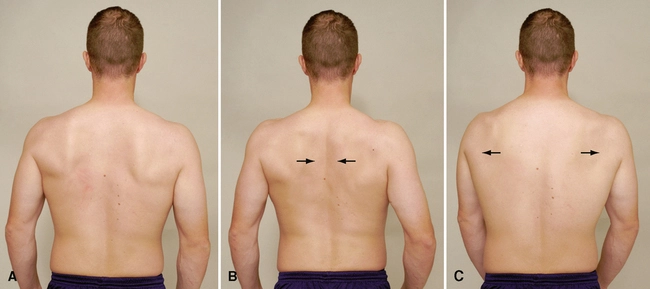
Your damaged arm is dangling over the side of the table or bed, and you are lying on your stomach.
You must lift the weight carefully and maintain a straight elbow joint.
Squeeze your shoulder blade as much as you can in the other direction.
Next, carefully go back to the beginning position and carry out this exercise once again.
Perform this workout three times daily.
Exercise for Bent-Over Horizontal Adduction:
Your damaged arm is dangling over the side of the table or bed, and you are lying on your stomach.
You have to lift your arm carefully to eye level while keeping it straight.
Repeat this exercise by lowering it gradually back to the beginning position.
Perform this workout three times daily.
Exercise for the Dumbell Pullover:
Just your neck and upper back should be supported when you lie across the bench.
Hold the dumbbell with both hands by forming a triangle with them or by gripping the inner plate.
With your elbows slightly bent, hold the dumbbell straight above your chest.
Remember to use your core as you slowly lower the dumbbell past your face and over your head.
Reposition the dumbbell over your face in its initial position.
Finish the five to ten repetitions.
One set at a time, repeat.
Exercise with Inverted Rows:
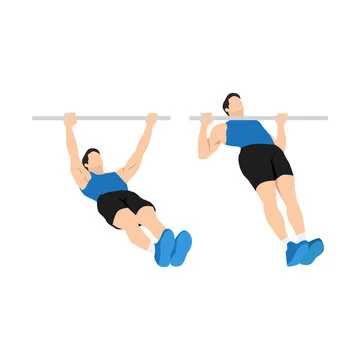
Place the bar just above the surface, a little higher than the length of an arm.
Stretch both of your legs out in front of you and sit beneath the bar.
Reach up and grasp the bar with both hands in an overhand grip that is wider than the distance between your shoulders.
Align your torso such that your heels are on the ground and your arms are straight.
Retract your shoulder blades until your chest touches the bar to pull yourself up.
Reduce gradually to the starting position.
Finish the five to ten repetitions.
One set at a time, repeat.
Yates Row Exercise Performed Underhand:
With both hands, grasp a barbell shoulder-width apart using an underhand grip.
Make a 45-degree angle with your hips by bending at the knees.
The bar should be over the thighs, and the arms should be nearly fully extended.
Raise the bar to your waist.
Now halt at the summit and gradually go back to the starting point.
Finish the five to ten repetitions.
One set at a time, repeat.
Lat Pull Down with Underhand Grip
Observe the cable machine while seated on a bench.
Reach up and place both hands, shoulder-width apart, in an underhand grip on the bar.
Bring the shoulder blades back and down to pull down on the bar until it reaches the chest.
Return to the starting position gradually.
Finish the five to ten repetitions.
One set at a time, repeat.
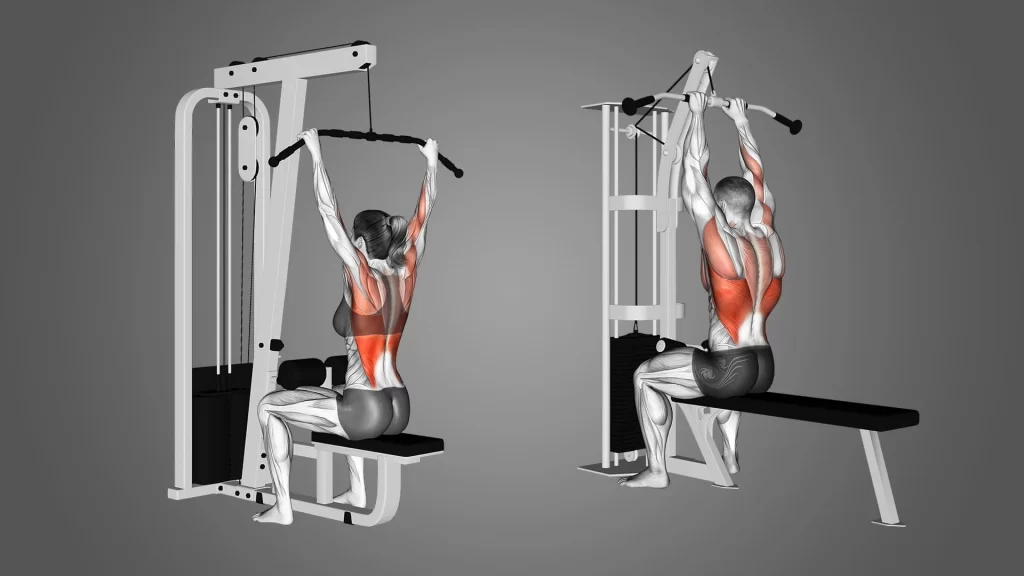
Lat Pulldowns
View the cable machine while seated on a bench.
With both hands slightly wider than shoulder-width apart, reach up and grasp the bar with an overhand grip.
Bring the shoulder blades down and back to pull the bar down until it reaches the chest.
Return to the starting position gradually.
Finish the five to ten repetitions.
One set at a time, repeat.
Chin-ups Exercise:
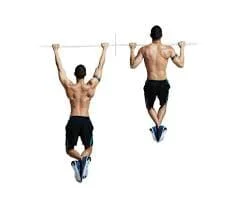
Hold the bar with your palms, using an underhand grip, with your hands shoulder-width apart.
As you elevate your chest as high as you can towards the bar, begin with your arms fully extended.
Hold for a little while at the top, then take a step back to start.
Finish the five to ten repetitions.
One set at a time, repeat.
Single-Arm Dumbell Row
With your right hand, hold a dumbbell in a neutral grip. Then, place your right knee and hand beneath your shoulder on a bench.
With your left arm extended straight beneath your left shoulder, grab the dumbbell.
When the dumbbell is near the hip, pull it upward while bending at the elbow and keeping the arm close to the body.
Reduce gradually to the starting position.
Finish the five to ten repetitions.
One set at a time, repeat.
Seated Cable Rows
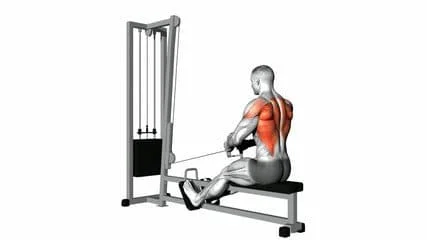
Sit on a bench with your knees bent, then stretch forward to grab the triangle handle.
Squeeze the shoulder blades together and maintain your back straight as you pull the handle back towards your navel.
Return to the starting position gradually.
Finish the five to ten repetitions.
One set at a time, repeat.
Reverse Crossover Fly with High Cable.
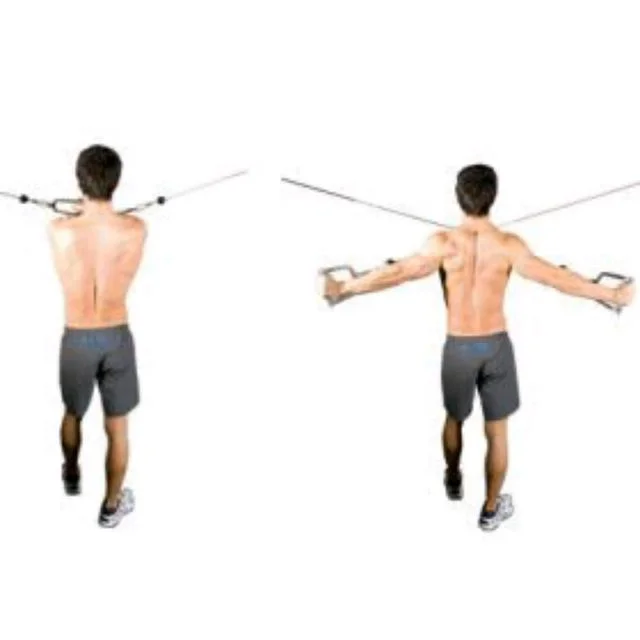
Start the cable machine with both grips at head height.
Place yourself in the middle of the two-pulley apparatus.
Using both hands, reach up and across your body and grasp the grips with an overhand hold (or grab the cables)
Until the arms are parallel to the back, pull the elbows down, out, and back as far as you can.
Return to the starting position gradually.
Finish the five to ten repetitions.
One set at a time, repeat.
Exercise for Cable Supine Reverse Fly:
Start with a bench between two pulleys.
Grab both handles (the cable) with an overhand hold as you reach up across your torso.
With your arms crossed across your chest and your elbows slightly bent, take a seat on the bench.
Maintaining the arms perpendicular to the torso, pull the arms down to the sides until the elbow is level with the shoulders.
Return to the starting position gradually.
Finish the five to ten repetitions.
One set at a time, repeat.
Exercise for the Dumbell Reverse Fly:
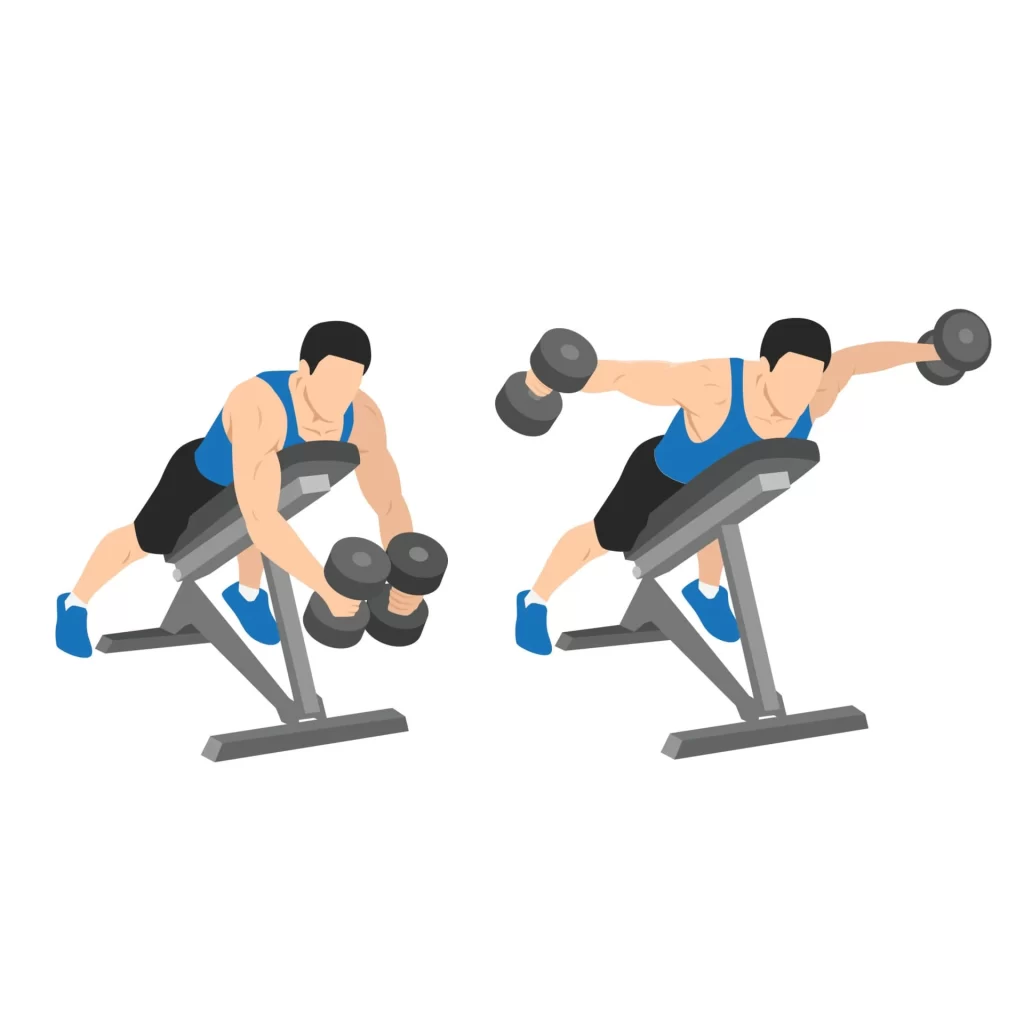
Using both hands, grasp the dumbbells with a standard grip.
After that, bend at the hips to bring your body nearly parallel to the ground.
Dumbbells should be pulled up and back until the elbows are level with the shoulders, starting with the arms hanging down from the shoulders.
Reduce gradually to the starting point.
Finish the five to ten repetitions.
One set at a time, repeat.
Exercise using band pull-aparts:
Stand up straight.
Using an overhand grip, hold the band towards the ends.
Raise your arms shoulder-height in front of you, outward.
Squeeze the shoulder blades together to spread the band apart.
Reduce gradually to the starting point.
Finish the five to ten repetitions.
One set at a time, repeat.
Exercise with Face Pulls:
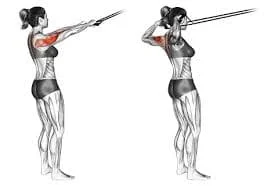
Hold the cable at head height.
Using an overhand grip, seize the rope and handles.
Pull back with the elbows positioned below the shoulders until the hands are parallel to the face.
Return to the starting position gradually.
Finish the five to ten repetitions.
One set at a time, repeat.
Breathing exercise:
While breathing exercises are generally linked to enhanced respiratory function and lung capacity, they can also be advantageous for the latissimus dorsi. Breathing exercises can be beneficial for the latissimus dorsi muscle for the following reasons:
- Improved Muscle Function: By activating the latissimus dorsi, deep breathing workouts can enhance the muscle’s strength and flexibility. This is especially helpful for people who depend on their upper body strength, like sports.
- Better Posture: Breathing exercises that are appropriate can help improve posture, which lessens the tension on the latissimus dorsi. Breathing exercises can help maintain healthy posture, which can help prevent muscular imbalances and discomfort.
- Stress Reduction: Breathing techniques can ease tension and stress throughout the body, especially in the back muscles. Less tension and soreness can develop in relaxed muscles, which is advantageous for the latissimus dorsi.
- Increased Oxygen Supply: Breathing deeply helps the muscles, especially the latissimus dorsi, get more oxygen. Increased oxygenation can enhance the function and recuperation of muscles.
- Enhanced Core Stability: The core muscles are worked during many breathing exercises, particularly diaphragmatic breathing. In addition to supporting the latissimus dorsi and other back muscles, a strong and stable core can enhance the strength and function of the upper body as a whole.
Special Breathing Techniques for the Latissimus Dorsi:
Diaphragmatic Breathing:
in the supine position
your head supported at the bottom while lying on your back on a surface or in bed, with your knees bent. To support your legs, place a pillow behind your knees.
With one hand on his upper chest and the other slightly below your skeleton, place your hands. as you breathe and feel the movement of your diaphragm.
Inhale slowly while using your nose to push your abdomen out of the way, allowing your hand to raise.
The hand on your chest should remain as steady as possible.
Tighten your abdominal muscles and let them drop in while you let your lips fall. The hand on your abdomen should return to its starting position.
seated in a chair with your knees bent and your head, neck, and shoulders in a neutral position. You can do this five or six times a day for seven to ten minutes each time. Exercise for the diaphragm, often known as an associated exercise.
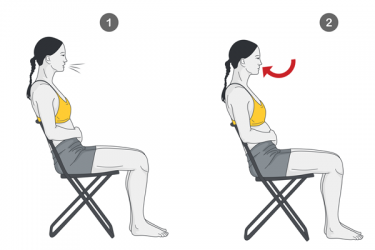
In sitting
Maintain a straight posture while sitting and increase the space between your sternum and umbilicus.
You should have a relaxed neck and shoulders.
The pelvis is positioned neutrally.
The side of your lower ribs should be where your hand is positioned.
Inhale slowly through your nose. Your ribs should be facing upward and outward as you are inspirited. The trunk expands in three directions during inspiration: forward, sideways, and back. expiration with the use of your nose. Your lower ribs shift inside as you collapse.
Exercise with pursed lips
Lying down or sitting with your back straight. Give your neck and shoulders as much relaxation as you can.
When you inhale through your nose for two to three seconds, air enters your abdomen. Inflate your abdomen, rather than your lungs, with air.
Press your lips together as though you’re chewing hot food, and then slowly release the air, taking twice as long to do so as it did to inhale.
You can continue for a number of times. You’ll increase the count of inspiration and expiration from two to four seconds, and so on.
Abdominal Deep Breathing:
Choose a cosy spot to sit or lie down.
Put your hands on your stomach.
Breathe deeply through your nose, letting your stomach grow.
Feel your tummy compress as you gently release the breath through your mouth.
This aids in activating the latissimus dorsi and widening the thoracic cavity.
Expanding the Chest:
Maintain your back straight.
Breathe in deeply, opening your arms and chest wide.
Keep the breath held for a short while.
Return your arms to your sides and exhale slowly.
This exercise improves thoracic flexibility and stretches the latissimus dorsi.
Benefits of exercise:
Working out the latissimus dorsi, or “lats,” has many advantages that improve general health and physical performance. The following are the main advantages of including latissimus dorsi exercises in your fitness regimen:
- Enhanced Upper Body Strength Functional Movements:
- Pulling, lifting, and reaching are all part of daily chores that can be made easier by strengthening your lats. Examples of these duties include carrying groceries, opening heavy doors, and moving furniture.
- Athletic Performance: Power generation and endurance are key components of strong lats in sports and activities like rock climbing, swimming, rowing, and gymnastics. They enable you to exert more force and exert yourself for longer periods of time.
- Improved Alignment
- Support for Posture: The latissimus dorsi muscles are essential for keeping good posture. They lessen the propensity to adopt a rounded or slumped shoulder position, which can cause discomfort and long-term problems. Instead, they help keep your shoulders back and your spine in alignment.
- general Spinal Stability: Strong lats support the thoracic spine, which helps to reduce back pain and enhances your ability to stay upright and in alignment. This prevents general spinal instability.
- Injury Prevention
- Balanced Muscle Development: By focusing on the lats, one may minimise muscular imbalances that can result in injuries and ensure balanced muscle development across the upper body. For example, well-developed lats aid in balancing the muscles of the shoulders and chest.
- Joint Protection: When engaging in a variety of activities, strengthening your lats can help protect your shoulder joints. By keeping the shoulder joints solid and well-supported, this is essential for avoiding shoulder ailments, including rotator cuff strains.
- Improved Sports Results
- Power and endurance: Strong lats are helpful for pulling and lifting objects, which is important for martial arts, swimming, and rowing exercises. Enhanced power also translates into enhanced athletic performance in general.
- Versatile Movement: Due to its extensive range of upper body movements, the latissimus dorsi is crucial for adaptable and effective performance in a variety of sports. This covers motions such as climbing, throwing, and swinging.
- Ability to Function
- Daily Tasks: Having stronger lats will improve your ease and efficiency in carrying out daily tasks. It becomes easier to handle household maintenance, carry children, and lift large objects.
- Complex Movements: Compound movements are a common component of lat exercises, and they enhance functional fitness in general. Better balance, coordination, and body control result from this.
- Visual Appeal
- Definition of Muscle: An attractive V-shaped torso is typically attributed to well-developed latissimus dorsi muscles. This form highlights a slimmer waist and a larger upper body.
- Symmetry and Balance: Strengthening your lats improves the overall appearance of your upper body by helping to build a balanced, symmetrical physique. This harmony is crucial for both appearance and practical power.
- Function of the Respiratory System
- Assistance with Breathing: During deep breathing, the latissimus dorsi muscles help to expand and constrict the thoracic cavity. Increasing the strength of these muscles can help with breathing efficiency and lung capacity.
Effective exercises for the latissimus dorsi
It is imperative to incorporate specialised exercises that target the latissimus dorsi in order to get these benefits. Among the effective exercises are:
Pullups & chinups: Exercises that specifically target the lats and develop upper body strength are pull-ups and chin-ups.
Lat pulldowns: This machine-based workout imitates the pull-up motion and offers resistance that can be adjusted.
Exercises like dumbbells and bent-over rows work the lats and other back muscles in a balanced way.
Deadlifts: As part of a full-body workout, this compound movement works the lats.
Seated Rows and T-Bar Rows: These workouts work the lats and other muscles of the upper back with the aid of machines or barbells.
Precautions to take during latissimus dorsi exercises:
Key safety measures to follow when performing latissimus dorsi exercises are as follows:
- Warm Up Correctly: Perform active upper body stretches and light aerobics for five to ten minutes.
- Maintain Correct Form: To reduce the risk of injury and increase muscular activation, keep your shoulders down and your back straight.
- Avoid Overarching the Back: To preserve your lower back, maintain a neutral spine and contract your core.
- Manage Your Motions: Execute workouts deliberately and gradually, steering clear of momentum.
- Use the Right Weight: As you gain strength, progressively increase from a manageable starting weight or resistance.
- Maintain a mindful posture with your shoulders back and down; refrain from hunching over or rotating forward.
- Breathe correctly: pull up when you exhale during an effort and lower down when you inhale during rest.
- Prevent overtraining: Give yourself 48 hours of recuperation in between lat-focused sessions.
- Cool Down and Stretch: After your workout, spend five to ten minutes doing static stretches and gentle aerobics.
- Check for Pain: If you feel a sharp pain, stop, and if it doesn’t go away, get help from a specialist.
How Frequently Should Your Latissimus Dorsi Be Trained?
Frequency: Try to work out your latissimus dorsi two or three times a week.
Recovery and Rest:
Recovery Periods: Make sure to give your muscles at least 48 hours off in between lat-focused workouts in order to promote muscular growth and healing.
Variety in Exercises: Mix up your routines to target your muscles in new ways and avoid overuse issues.
Balance with Other Muscle Groups:
Upper Body Routine: To maintain total muscular balance and avoid imbalances, balance your lat workouts with exercises that target other upper body muscles (chest, shoulders, and arms).
Overall Fitness: For a well-rounded training programme, incorporate core and lower body activities into your schedule.
Progressive Overload:
Increase Resistance: As your strength increases, progressively raise the weight or resistance.
Adjust Volume: To keep your muscles challenged, gradually increase the number of sets and repetitions.
Paying Attention to Your Body:
Avoid Overtraining: Keep an eye out for overtraining symptoms, like chronic soreness, exhaustion, or diminished performance. If required, change the frequency of your training.
Recovery: To improve muscle recovery and general performance, make sure you get enough sleep, eat a healthy diet, and drink plenty of water.
Your latissimus dorsi muscles can be efficiently strengthened and their function improved by training them 2-3 times a week with appropriate rest, balanced workouts, and progressive overload.
FAQs
What function does breathing involve in the latissimus dorsi?
In order to support respiratory function during deep breathing, the latissimus dorsi helps to expand and contract the thoracic cavity. The latissimus dorsi can be strengthened and made more flexible with breathing exercises.
Can posture be affected by tight lats?
Yes, a hunched or rounded shoulder appearance can result from tight latissimus dorsi muscles dragging the shoulders downward and forward. Exercises for strengthening and stretching can help with this.
What connection exists between core stability and the latissimus dorsi?
To stabilise the spine and pelvis, the latissimus dorsi collaborates with the core muscles. The latissimus dorsi’s stability and function can be improved by a strong core, which also increases upper body strength and movement efficiency.
What role does the latissimus dorsi play in sports performance?
For a variety of sports activities that require pushing, lifting, and reaching, the latissimus dorsi is essential. Gymnastics, rock climbing, swimming, and rowing are among the sports where having strong and flexible lats improves performance.
What muscle is the latissimus dorsi?
Often called the “lats,” the latissimus dorsi is a big, flat muscle in the back. It is essential to many upper body movements and spans from the lower spine and pelvis to the upper arm.
How can I make my latissimus dorsi stronger?
The following are some latissimus dorsi strengthening exercises:
Chinups and pull-ups, lateral pulldowns, overturned rows, dumbbell rows, deadlifting, swimming, especially the backstroke and front crawl.
Is it possible to injure the latissimus dorsi?
It is possible to strain or injure the latissimus dorsi, particularly when engaging in tasks that require heavy lifting, repeated overhead motions, or abrupt, vigorous movements. Injuries can cause pain, edoema, and restricted range of motion.
Why should I work out my muscles in the latissimus dorsi?
Strengthening the lats helps maintain shoulder stability, strengthen the upper body, improve posture, reduce the risk of injury, and create a well-proportioned, attractive figure.
What at-home latissimus dorsi exercises are good for me?
Pull-ups, inverted rows, bent-over rows, superman exercises, tension band pulldowns, dumbbell pullovers, and towel rows are some of the most efficient at-home workouts.
How often should my latissimus dorsi get exercise?
In order to minimise overtraining and encourage muscle recovery, train your lats two to three times a week and give yourself at least 48 hours of rest in between.
What tools are necessary for at-home latissimus dorsi exercises?
A pull-up bar, dumbbells or filled water bottles, resistance bands, and a solid table or bar for inverted rows are basic pieces of equipment for lat workouts performed at home.
References:
Jyoti. (2022, July 13). Latissimus Dorsi Muscle – Anatomy, Origin, Insertion, Exercise. Samarpan Physiotherapy Clinic. https://samarpanphysioclinic.com/latissimus-dorsi-muscle/
Prajapati, N. (2022b, December 3). Latissimus dorsi muscle strengthening exercise Health Benefits. Samarpan Physiotherapy Clinic. https://samarpanphysioclinic.com/latissimus-dorsi-muscle-strengthening-exercise/
Cronkleton, E. (2019, June 3). 10 Ways to Stretch and Strengthen Your Lats. Healthline. https://www.healthline.com/health/lat-stretches
Physio, S. (n.d.). Top 5 Exercises to Stretch Your Lats – Surrey Physio. Surrey Physio. https://www.surreyphysio.co.uk/top-5/top-5-exercises-to-stetch-your-lats/
Fletcher, J. (2023, July 28). How do you stretch the latissimus dorsi? https://www.medicalnewstoday.com/articles/321623
Mark. (2022, May 25). The 10 Best Latissimus Dorsi Stretches. Posture Direct. https://www.posturedirect.com/latissimus-dorsi-stretches/
Cpt, P. W. (2022, November 21). 16 Best Latissimus Dorsi Exercises. Verywell Fit. https://www.verywellfit.com/great-mid-back-lats-exercises-1231482
CSCS, D. O., & Nasm, B. W. (2024, March 4). The Top Lat Moves to Build a Stronger Back. Men’s Health. https://www.menshealth.com/fitness/a25940847/best-lat-exercises/
Z, T. (2023, February 14). The 10 Best Exercises to Build Bigger and Stronger Lats. TRX Training – United States. https://www.trxtraining.com/blogs/news/lats-exercises
Set, S. F. (2024, May 7). 14 Best Latissimus Dorsi Exercises To Build Some Serious Wings. SET FOR SET. https://www.setforset.com/blogs/news/best-latissimus-dorsi-exercises



